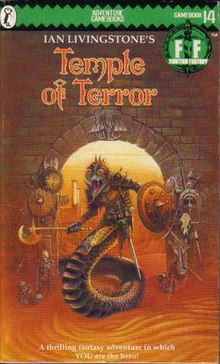Temple of Terror
 The original Puffin Books cover (1985) | |
| Author | Ian Livingstone[1] |
|---|---|
| Illustrator | Bill Houston |
| Cover artist | Christos Achilleos |
| Series | Fighting Fantasy
|
| Genre | Fantasy Location: Allansia, Titan |
| Published | Puffin: 1985[1] Dell/Laurel-Leaf: 1986[1] |
| ISBN | 0-14-031832-1 (Puffin) ISBN 1-84046-528-X (Wizard) |
Temple of Terror is a single-player role-playing game-book written by Ian Livingstone, illustrated by Bill Houston and originally published in 1985 by Puffin Books. It was later republished by Wizard Books in 2004. It forms part of Steve Jackson and Ian Livingstone's Fighting Fantasy series. It is the fourteenth in the series in the original Puffin series (ISBN 0-14-031832-1) and 19th in the modern Wizard series (ISBN 1-84046-528-X).
Rules
As with titles such as House of Hell and Appointment with F.E.A.R., Temple of Terror utilizes an additional game mechanic: five letters have been scattered throughout the story, and if the player finds all five letters they spell the word DEATH and the player instantly dies, ending the game.
Story
Temple of Terror is a fantasy scenario.[1]
The reader plays as a wandering adventurer who is recruited by the good wizard Yaztromo (who previously appeared in The Forest of Doom) and tasked with locating the five dragon artefacts (bone, crystal, ebony, gold and silver) which are hidden in the lost city of Vatos. Gameplay takes the form of a campaign: the player must determine a means of traveling through the Desert of Skulls, find and scour Vatos for the amulets whilst overcoming various traps and monsters and finally defeat Malbordus. Successful completion of the quest requires the player from the first paragraphs to acquire items that will assist in future situations.
See also
References
- ^ a b c d Schick, Lawrence (1991). Heroic Worlds: A History and Guide to Role-Playing Games. Prometheus Books. p. 367. ISBN 0-87975-653-5.
External links
- "Temple of Terror on the official Fighting Fantasy website".
- "Temple of Terror on the Wizard Books website".* "Temple of Terror on gamebooks.org".
- "Temple of Terror on the Internet Archive record of the old fightingfantasy.com site". Archived from the original on 2005-11-27.
Official sites:
